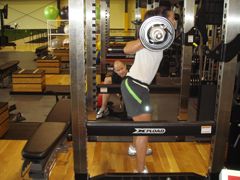During my travels over the past week or so, I have taken the opportunity to pick up one or two papers that had been recommended to me on various topics. Given my interest in what is going on around the hip & pelvis in addition to a discussion with my colleague, James Moore, discussing one of my athletes, he suggested I read the 2006 Cara Lewis & Shirley Sahrmann paper on labral tears & femoral acetabular impingement (or FAI). I must say it was a very thorough review (given the authours what would you expect?) & then today, as I was flicking through the blogs I take chance to read, I came across the following report submitted by Phyllis Fisher at the Hospital for Special Surgery reporting a study investigating the efficacy of hip arthroscopy in attaining improved hip range of movement.
Arthroscopic treatment of a common hip problem that leads to arthritis is successful in terms of restoring range of motion, according to results from a recent Hospital for Special Surgery study. The study will be presented at the annual meeting of the American Orthopaedic Society for Sports Medicine, held July 7-11 in San Diego.
"This is the first study to show that in patients who are being treated for hip impingement with arthroscopy, not only do we restore their mechanical measurements, but by doing so, we have improved their functional range of motion across the joint," said Bryan T. Kelly, M.D., co-director of the Center for Hip Pain and Preservation at Hospital for Special Surgery in New York.
This study received the 2011 Excellence in Research Award from the American Orthopaedic Society for Sports Medicine.
In recent years, a hip condition known as femoro-acetabular impingement (FAI) or hip impingement has become widely recognized as one of the most common causes of early osteoarthritis in the hip. The hip is a ball-and-socket joint where the upper end of the thigh bone fits into the cup-shaped socket of the pelvis. In a healthy hip joint, the ball rotates freely in the cup, but in some people a bony bump on the upper thigh bone produces a situation where there is inadequate space for the hip bone to move freely in the socket. The result is damage to the socket rim and the cartilage that lines the bones, which can lead to hip arthritis.
Structural correction of the bone through arthroscopic or open surgery has been shown to be successful at relieving symptoms of FAI and returning athletes to their sport of choice. Before this study, however, researchers had not studied how good arthroscopic repair was at restoring range of motion.
To find out, researchers at Hospital for Special Surgery in New York City used computer-assisted, three dimensional analysis to assess differences in hip range-of-motion before and after the arthroscopic treatment of FAI. The study included 10 patients with symptomatic FAI who underwent a computed tomography (CT) scan before and after surgery. The CT scan was then fed into a software program that generated a three dimensional, animated picture of their hip joint.
"Their hip is moved in the computer program until there is collision between the ball and the socket. It assesses the point at which impingement occurs," explained Dr. Kelly. "Postoperatively, another CT scan is obtained and we assess the same range of motion."
The researchers found great improvements in internal rotation, moving your knee to the middle of your body, and in hip flexion, the motion of bringing your knee to your chest. Hip flexion was improved by 3.8 degrees and internal rotation was improved by 9.3 degrees. A comparison of the alpha angle, which measures the roundness of the femoral head (ball of the thigh bone), showed an improvement of roughly 20 degrees.
"Before this study, we did not know what our ability was to functionally improve range of motion across a hip joint in a patient who has had surgical correction of their underlying hip impingement," said Dr. Kelly. "With this study, we have clear objective data, confirming with dynamic assessment, that by improving the mechanical shape of the joint, we significantly improve range of motion and significantly reduce the areas of bony conflict."

